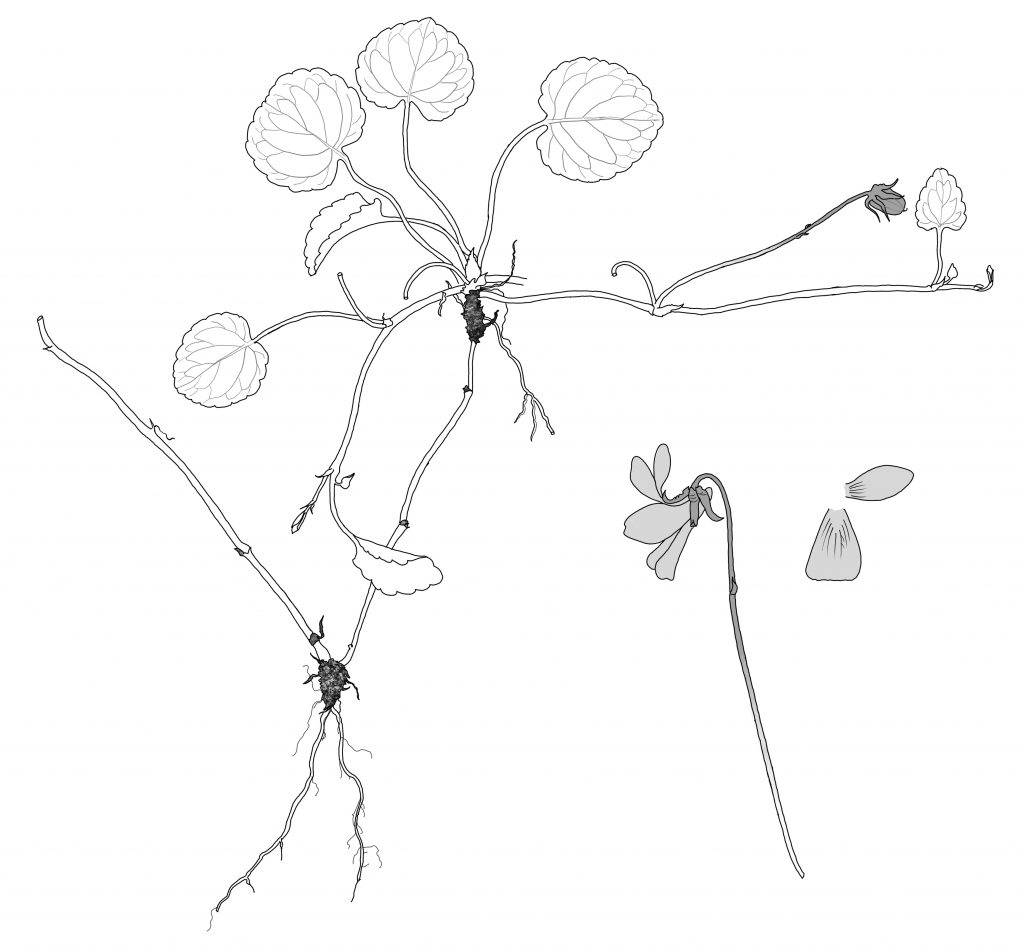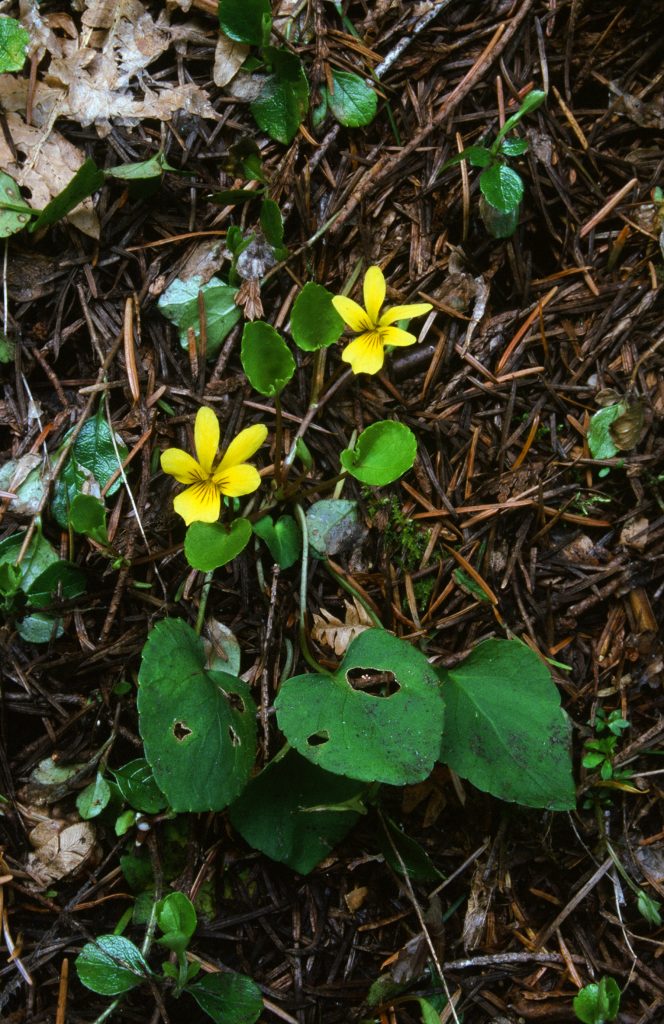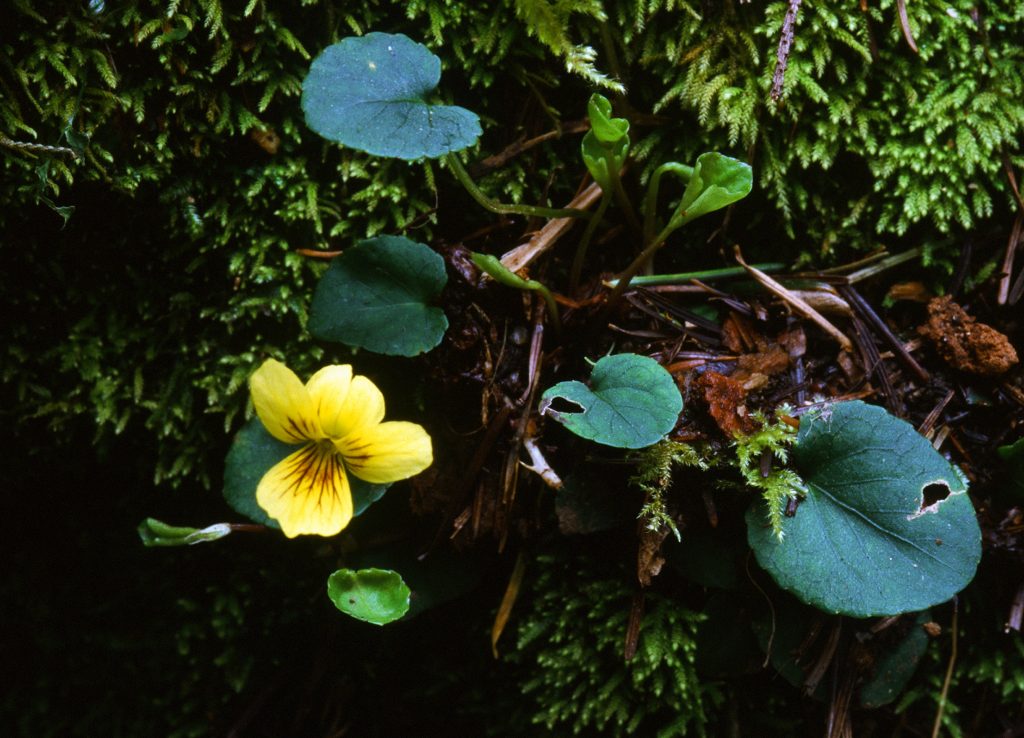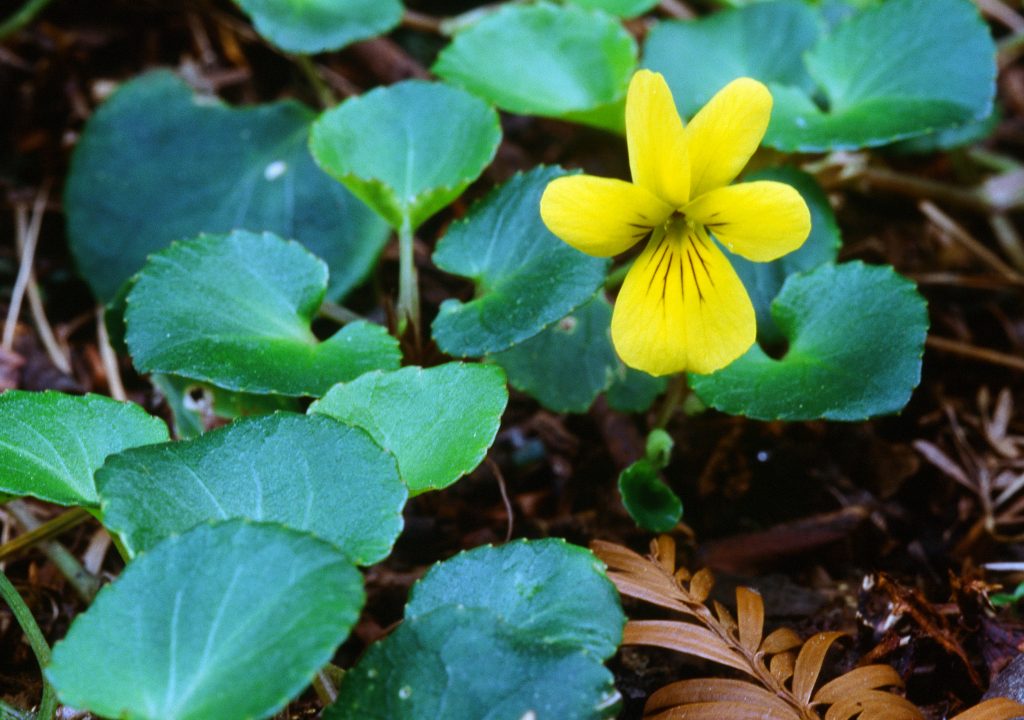Viola sempervirens, Greene
Kim’s notes and references, unedited. Illustrations: 4 photographs of Viola sempervirens and 2 drawings

Viola sempervirens Greene
Edward Lee Greene, 1843-1915.
‘sempervirens’ refers to the fact that it is evergreen.
syn. Viola sarmentosa Dougl. not Bieb.
Produces cleistogenes
In SW corner of BC, Canada. For plant details see e-Flora BC website.
See Abrams L. R. & R.S. Ferris. An Illustrated Flora of the Pacific States: Geraniaceae to Scropulariaceae, Vol. 3. 1951. Stanford University Press.
Section Chamaemelanium, subsection Orbiculares (Marcussen, 2011). Our samples of V. douglasii and V. sempervirens were clearly octoploid, though both taxa also occur in tetraploid races (Clausen, 1964). (Marcussen et al, 2011) [guadalupensis paper]
Jepson on-line: V. sempervirens Greene

EVERGREEN VIOLET
Plant 2–15 cm; stolons with scattered leaves, at nodes rooting, rosette-forming
Stem erect from scaly rhizome
Leaves basal and cauline, simple, leathery, evergreen; hairs 0 to sparse, especially on veins; petiole 10–160 mm; blade 10–40 mm, generally wider than long, generally purple-spotted on 1 or both surfaces, crenate, base cordate, tip obtuse
Inflorescence: peduncle 50–100 mm
Flower: petals lemon-yellow, lowest (including spur) 8–17 mm, very wide, lower 3 veined purple, lateral 2 bearded
Fruit < 7 mm, purple-mottled
Chromosomes: n=12, 24; 2n=4x=24 & 2n=8x=48
Ecology: Coastal forests
Elevation: 30–1400 m.
Bioregional distribution: Northwestern California, Central Western California [south to Coastal Ranges just north of Santa Barbara.]
Distribution outside California: to British Columbia


Redwood Violet. SFO Wildflowers CD: name refers to evergreen habit. Creeping rooting stems/stolons, flowers April-May. Shaded banks of Redwood forests, also common in the bishop pine forests of Port Reyes Peninsula.
Hultén E., Flora of Alaska and Neighboring Territories, Stanford University Press, California, 1968:
Very similar to V. biflora; caudex and stem with stolons. Shaded woods.
TM, 19 Aug, 07: V. glabella and V. brevistipulata were originally thought to be conspecific, but the former turned out to have 2n=12 and the latter 2n=24 (counted by Miyaji and Clausen, I think). Whether this distinction holds throughout their range is another question, as many of the Chamaemelanium species are polymorphic. Both V. douglasii and V. sempervirens have either 2n=24 or 48. At least my sample of V. sempervirens is obviously 2n=48, but so badly recombined in the PCR that the different copies cannot be separated, except for one.
Seeds mid size, pale brown, mature? Seeds red-brown.
From 2000 catalogue, Ron Ratko: Neahakanie Mtn., Oregon Coast Ranges, Tillamook Co., OR. 1300’. Small prostrate, evergreen rosettes of dark green, cordate-ovate leaves. The leaves are faintly purplish dotted. The dark yellow, purple-lined flowers peak out of the foliage on small aerial stems that are shorter than the leaf petioles. The non-flowering aerial stems elongate and become stoloniferous. In general smaller in habit and flower than V. orbiculata. Shaded Sitka spruce forests in coarse loamy soils with some needle duff, acidic.
Photographed on Route 299, E. from Arcata, CA, roadside, deep shade. Coast Ranges.

Rogue River valley, Oregon, with Tom and Inger. Very damp, high moisture content of very rich soil, evergreen Redwoods? Coast Ranges.
Also south east of Orick, in the evergreen Redwoods forest, on roadside. Fog-shrouded. Coast Ranges. Soil derived from Franciscan sedimentary rocks, muds and sands and cherts inter-layered with basalt lava flows, originally deposited far from shore on the floor of the Pacific Ocean 150-100 million years ago, then scraped up from the oceanic trench as the ocean floor descended under the continental shelf.
Washington State, Berge Road, from Route 14 along the Columbia River Gorge, east of Carson, West of Dog Mountain, and west of Bergen Road, go north, on Berge Road to 1 mile post (RHS), turn left at corner, is in the wood immediately on the right, but only a couple of plants. In seed at end of May, 2003.
Russ Jolley: Evergreen violet. Height 2-5 in. [V. orbiculata 4-8 in. but not always, remember the specimens on Olympic Peninsula]. Coniferous woods at all elevations in the west Columbia River Gorge. Mid-April: Beacon Rock Trail, Washington side of the Gorge, approx 800 feet high rock near Milepost 35 on SR 14, part of Beacon Rock State Park. Easy 0.9 mile trail just west of parking area leads to top. Mid-June: top of Larch Mountain. For description of location see file for V. orbiculata. They are both present at the same location. Is V. orbiculata evergreen? Probably not.
Also Mt. St. Helen’s Nat. Park..
Line drawing of Viola sempervirens in book of wildflowers of west coast (Peterson Field Guide) with arrow pointing to notch in end of keel petal is misleading as differentiating characteristic because it is not constant.
Photographed in the East Bay Regional Parks Garden, which is near the U. C. Botanic Garden, Berkeley, California. Under evergreen redwoods.
[Directions to the East Bay Regional Parks Garden: Go across the Bay Bridge and take the Berkeley off ramp (north on 80). Get off at University Avenue and go east to where it dead ends. Turn left here on Oxford and keep in the right hand lane. Turn right at the edge of the campus, (Hearst). Then turn right on Garvey, past the Greek theater and turn left on the small road on the left shortly past this. It goes around in back of the stadium. You turn left at the first road you come to which will be Centennial Drive. It goes right past the U.C. Botanical Garden. Continue up the hill past the Lawrence Hall of Science, and on to the end of Centennial. You then go across Grizzly Peak Blvd. Into the Regional Park. The road is called Golf Course Drive. Keep bearing right until you get to the Regional Park botanic Garden. Parking is on the right.]
I was introduced to the East Bay Garden by Adele and Lewis Lawyer, who were very generous and enthusiastic introducing me to viola sites around the Bay area, and southeast to the locations around Livermore.
Viola sempervirens Pacific Fritillary Reference for information below is website: USGS Butterflies of N. America: www.npwrc.usgs.gov.
Pacific Fritillary (Boloria epithore [W. H. Edwards])
Wing span: 1 3/8 – 1 3/4 inches (3.5 – 4.5 cm).
Identification: Tip of forewing rounded. Upperside bright orange; black markings large on basal half of wing, small on outer half. Underside orange with purple-brown markings; hindwing with postmedian row of dark circles.
Life history: Males patrol for females all day in woods and meadows. Overwintering is by fourth-stage caterpillars.
Flight: One flight from May-August.
Caterpillar hosts: Violets including Viola ocellata, V. sempervirens, and V. glabella.
Adult food: Flower nectar.
Habitat: Openings in moist forests, wet meadows, streamsides.
Range: Central British Columbia east and south to Alberta and Montana, south along Pacific Coast to central California.
Conservation: Populations in California’s Santa Cruz Mountains are limited and may be in jeopardy.
Chromosome analyses shows that V. sempervirens originated by inter-subsectional hybridization between unidentified members of subsection Canadenses (maternal parent) and an unknown member of section Chamaemelanium (paternal parent), followed by allopolyploidy, a phenomenon that seems common within section Chamaemelanium and has occurred repeatedly in the last 9 million years, for V. sempervirens approximately 5.7 million years ago. V. sempervirens (8x); Orbiculares)
